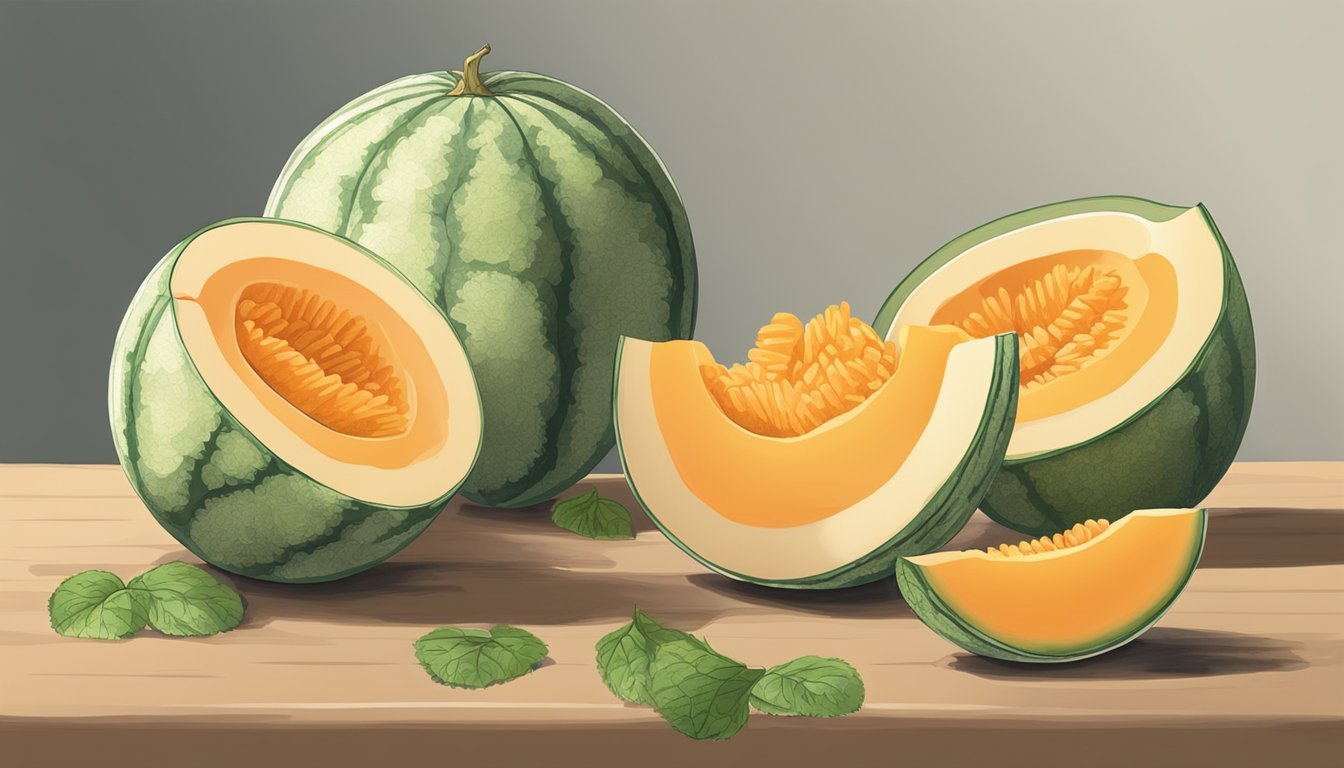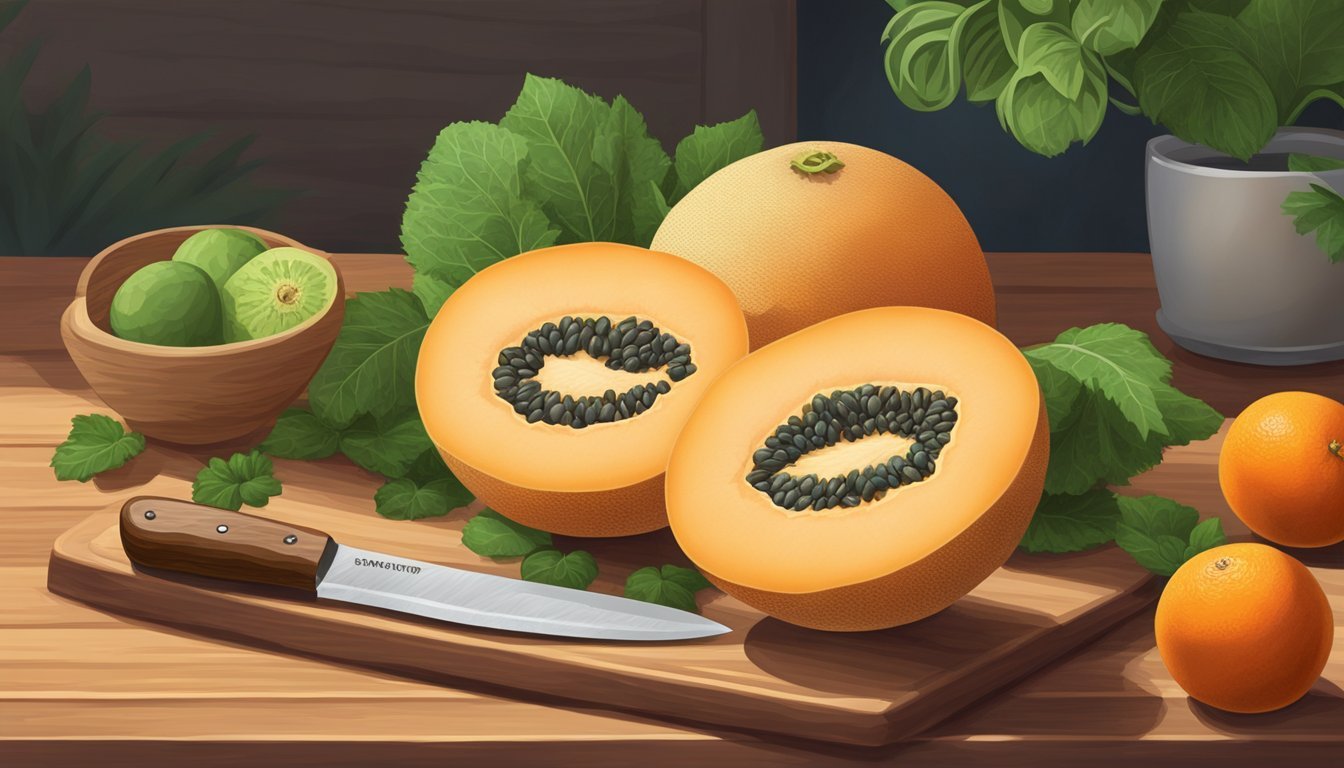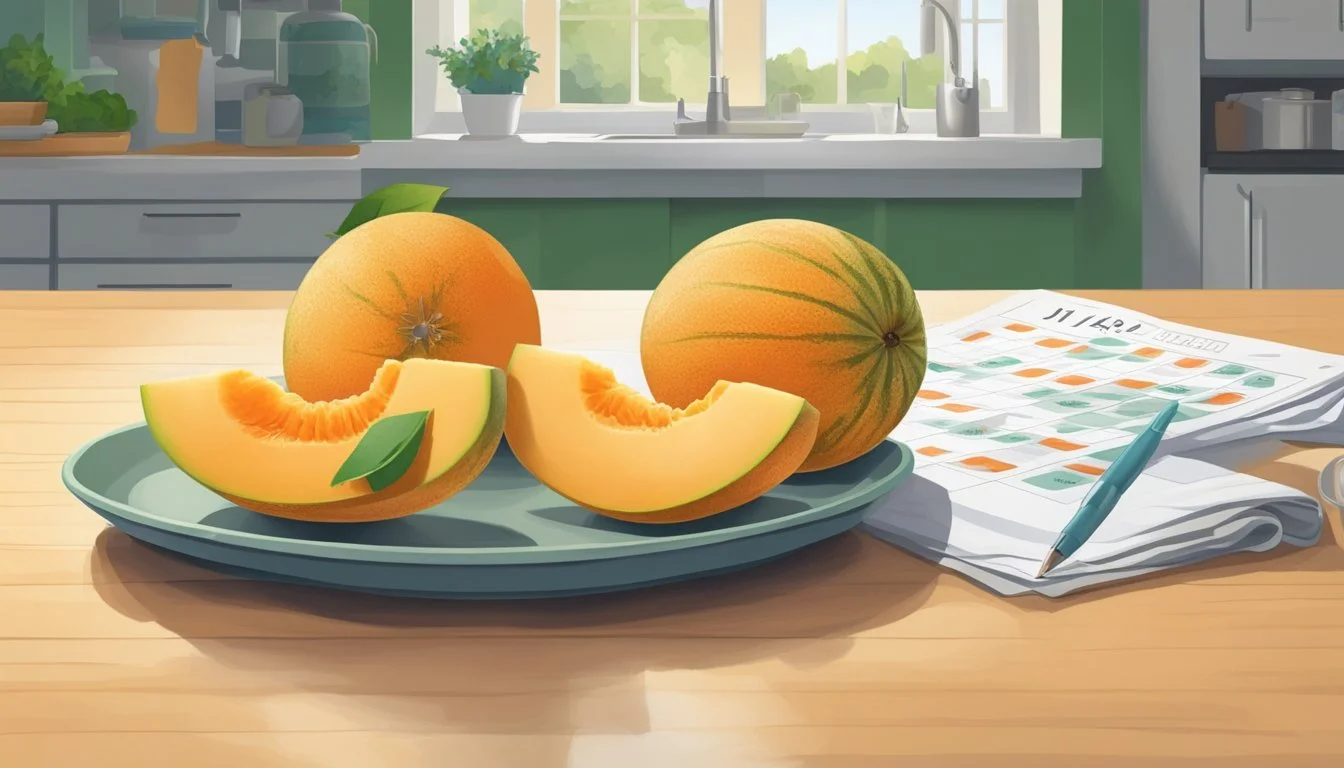How Long Does Cantaloupe Last?
Understanding Melon Shelf Life
Cantaloupes are a popular fruit known for their juicy and sweet flavor, but understanding their shelf life is crucial for both safety and taste. A whole cantaloupe (how long does cantaloupe last?) has a decent lifespan when stored under proper conditions. It can last about a week at room temperature, which makes it convenient for those who intend to consume it while it's perfectly ripe. However, the fridge can extend a cantaloupe's edibility significantly; depending on its initial ripeness, it may last up to two weeks when refrigerated.
Cutting into a cantaloupe changes its longevity. Once sliced, it should be kept in an airtight container and can be expected to remain fresh for 3 to 5 days in the refrigerator. Open-air storage is not recommended for cut cantaloupe as it is likely to spoil much faster, often within a matter of hours.
It is essential to identify the signs of a past-peak cantaloupe to avoid consuming spoiled fruit. A fresh cantaloupe has firm skin and a sweet, slightly musky scent. Over time, a cantaloupe that has spoiled may exhibit a soft texture, discoloration, and an unpleasant odor. If mold appears or the fruit emits an off-smell, it has gone bad and should be discarded.
Selecting a Quality Cantaloupe
Choosing a quality cantaloupe involves assessing its ripeness, freshness, and looking for any defects. The selected fruit should feel heavy for its size, indicating it is hydrating and will provide a sweet aroma when ripe.
Checking for Ripeness
To determine if a cantaloupe is ripe, one should examine the color and texture. A ripe cantaloupe typically has a creamy beige to golden color beneath its netting pattern. By gently pressing the stem end, one should be able to feel a slight give, indicating maturity. Moreover, the smell at the blossom end of the fruit should be fragrantly sweet, a clear sign of a ripe cantaloupe ready for consumption.
Identifying Freshness Indicators
Fresh cantaloupe can be detected by evaluating its seeds and interior. A fresh cantaloupe will have seeds that are snugly nestled in the cavity, surrounded by firm, brightly colored flesh. The rind should feel firm without any soft spots, ensuring that it has not begun to spoil.
Avoiding Common Defects
When inspecting cantaloupe for purchase, it's essential to avoid fruits (What wine goes well with fruits?) with visible defects. Soft spots or bruises may indicate areas where the fruit has started to deteriorate. Additionally, an uneven shape or an incomplete netting pattern may reflect irregular growth and potentially uneven ripeness within the fruit. Discolored areas or inconsistencies in texture should be taken as signs to select a different cantaloupe.
Cantaloupe Storage Basics
Proper storage of cantaloupe melons can significantly extend their shelf life and maintain freshness. Attention to temperature and whether the melon is cut or uncut plays a crucial role in preservation.
Room Temperature Storage
When dealing with uncut cantaloupes, the counter can be an acceptable storage area if the fruit is not fully ripe. An uncut, unripe cantaloupe can typically last about 5 to 7 days at room temperature. A ripe melon's rind should be intact and the fruit should be stored away from direct sunlight and heat sources to avoid overripening. The optimal temperature for storing a whole cantaloupe at room temperature should ideally hover around 50-60 degrees Fahrenheit (10-15 degrees Celsius).
Refrigerated Storage
Once a cantaloupe becomes ripe or has been cut, placing it in the refrigerator is the best option. A whole, ripe cantaloupe can last up to two to three weeks when stored properly in the fridge. It's best to store the melon in the least humid part of the refrigerator and avoid any spots that may contribute to quicker spoilage. For cut cantaloupe, it should be placed in an airtight container to retain freshness and should be consumed within 3 to 4 days to ensure quality and safety.
Maximizing Shelf Life
Proper storage of cantaloupe is crucial for maintaining its freshness and extending its shelf life. This section outlines how to store cantaloupes effectively, focusing on environmental conditions, handling uncut melons, and managing cut pieces.
Ideal Environmental Conditions
Cantaloupes thrive in cool environments, ideally between 45°F (7°C) and 50°F (10°C). Keeping them in such conditions slows down the ripening process and extends their freshness.
Storage Techniques for Uncut Cantaloupes
When storing an uncut cantaloupe, it is key to keep it whole until it's ripe. A whole, uncut cantaloupe can be kept in a plastic bag within the fridge to prolong its shelf life up to ten days. It is important to note that once a cantaloupe becomes ripe, it should be consumed quickly or prepared for storage.
Handling Cut Cantaloupe
Once a cantaloupe is cut, it should be stored in an airtight container or tightly wrapped in plastic wrap to prevent it from absorbing other flavors and odors from the fridge. In this form, cut cantaloupe should be kept in the fridge and is best consumed within five to seven days for optimal freshness.
Signs of Spoilage
When assessing the condition of a cantaloupe, specific visual cues and olfactory signals are key indicators of spoilage. It's important to recognize these signs promptly to avoid consuming fruit that may be harmful to one's health.
Visual Signs
Visual examination of the cantaloupe can reveal several signs that indicate the fruit has gone bad.
Mold Presence: Look for fuzzy white or green mold patches on the surface, which are clear indicators of spoilage.
Discoloration: The skin of an overripe or spoiled cantaloupe may exhibit light brown, dark brown, or black spots.
Texture and Smell
The condition of a cantaloupe can also be determined through touch and smell.
Soft Spots: A cantaloupe that feels mushy or has soft spots, especially those that are discolored or bruised, is likely rotting.
Sour Smell: An off-putting, fermented, or vinegar-like smell emanating from the fruit is a strong indication that the cantaloupe is no longer fresh.
When to Discard
Cantaloupe should be discarded in the following circumstances:
Mold Growth: If there's visible mold on any part of the fruit.
Severe Discoloration or Bruises: Large areas that are darkly discolored or bruised.
Unpleasant Odor: When the cantaloupe gives off a sour or fermented smell.
Compromised Texture: If the fruit's texture is overly soft and mushy to the touch.
Freezing and Preserving Cantaloupe
Properly freezing cantaloupe is a splendid way to preserve its freshness for extended periods. The process is straightforward and beneficial for those looking to enjoy this juicy fruit year-round.
Steps to Freeze Cantaloupe
Wash the fruit thoroughly.
Slice the cantaloupe open, remove the seeds, and peel the tough skin.
Cut the fruit into desired sizes—cubes are a practical choice for later use.
Pre-Freeze:
Line a baking tray with parchment paper.
Arrange cantaloupe pieces in a single layer to prevent clumping.
Place the tray in the freezer for a few hours until pieces are solid.
Storage:
Transfer the frozen pieces into airtight freezer bags or containers.
Remove excess air from bags to minimize freezer burn.
Label with the date to keep track of freshness.
Shelf Life and Usage
Duration: Cantaloupe can remain in good quality for up to one year when frozen.
Thawing:
Thaw in the refrigerator or at room temperature for immediate use.
Culinary Uses:
Incorporate frozen cantaloupe into smoothies for a cold and refreshing drink.
Use it in recipes where the texture of the fruit is less crucial, as freezing can slightly alter its consistency.
Add thawed cantaloupe to fruit salads, but expect a softer texture than fresh.
Freezing cantaloupe preserves the fruit's nutrients and taste. Consumers should keep in mind that texture may be compromised once thawed, making it best suited for blended dishes like smoothies or incorporated into recipes where the firmness of fresh cantaloupe is not essential.
Cantaloupe in Recipes and Cooking
Cantaloupe, with its sweet flavor and versatile nature, can enhance an array of dishes, from refreshing salads to innovative desserts and drinks. Whether it's sliced for a quick addition or blended into a smoothie, this sweet melon offers endless culinary possibilities.
Incorporating into Meals
When integrating cantaloupe into meals, one can consider its sweet and refreshing taste as a complement to both savory and sweet dishes. Salads are a prime example; adding sliced cantaloupe to a mix of greens, alongside a simple vinaigrette, can elevate the flavor profile substantially. Before adding to any meal, make sure to wash the cantaloupe thoroughly.
Salad Example:
Greens (spinach, arugula, etc.)
Sliced cantaloupe
Feta cheese
Optional nuts or seeds
Light vinaigrette dressing
This melon's versatility allows for its incorporation in various proteins as well, such as pairing with grilled chicken in a savory and sweet entrée.
Creative Uses in Desserts
Cantaloupe can be the star of desserts, employed in preparations that range from elegant to fun. The sweet melon can be turned into sorbets or served alongside other fruits for a healthy dessert option.
Dessert Ideas:
Cantaloupe sorbet
Fresh cantaloupe slices with whipped cream or yogurt
Cantaloupe and berry salad
Cantaloupe balls served with a drizzle of honey and mint
Its natural sweetness and moisture content make it a refreshing end to any meal, offering a light but flavorful option for those looking to satisfy their sweet tooth in a more health-conscious way.
Beverage Variations
Cantaloupe works splendidly in beverages, from a refreshing addition to a summer smoothie to a unique twist in cocktails and mocktails. Here is a simple smoothie recipe highlighting cantaloupe's rich flavor and health benefits:
Simple Cantaloupe Smoothie:
2 cups sliced and washed cantaloupe
1 banana
1/2 cup orange juice or coconut water
Ice cubes as needed
Blend until smooth
This melon’s sweet and subtly musky flavor can complement a range of liquid bases and other fruits, making it a valuable component for both its taste and its abundant nutritional content.
Health Benefits and Nutritional Information
Cantaloupe is a fruit known for its high water content and sweet aroma, making it a refreshing choice, especially on warm days. It is hydrating due to its approximately 90% water content. In terms of fiber, a serving of cantaloupe contributes to an individual’s daily intake, supporting digestive health.
Nutrients in Cantaloupe:
Fiber: Aids in digestion and promotes feelings of fullness, which can be beneficial for weight management.
Vitamin A: Essential for eye health and immune function.
Vitamin C: Important for immune defense and acts as an antioxidant.
Nutritional Breakdown per Serving (1 cup, balled):
Calories: 60
Protein: 1.5g
Carbohydrates: 14.4g
Fat: 0.3g
Vitamin A: Significant contributor
Vitamin C: Over 100% of the recommended daily value
Consuming cantaloupe contributes to a healthy diet due to its nutrient-dense profile, providing essential vitamins and minerals while remaining low in calories and fat. Cantaloupe is an excellent source of potassium, which can assist in maintaining healthy blood pressure levels.
The fiber, potassium, vitamin C, and choline content in cantaloupe not only facilitate hydration but also support heart health. Incorporating cantaloupe into one's diet is a sweet, nutritive way to enrich one's intake of essential nutrients.
Safety and Health Considerations
When handling and storing cantaloupe, one must consider the potential risks of foodborne illness. Cantaloupes, like other fruits, can harbor bacteria that lead to sickness if not handled properly. Understanding and applying food safety practices is essential for preventing illness and maintaining the freshness and ripeness of the fruit.
Preventing Foodborne Illness
Pathogen Exposure: Cantaloupes grow on the ground and can come into contact with harmful bacteria present in soil. It is imperative to wash them thoroughly before consumption.
Listeria Concerns: There have been instances where cantaloupe has been linked to listeria outbreaks. Proper handling, including cleaning utensils and surfaces used for cutting, helps reduce the risk of contamination.
Best Practices for Food Safety
Assessing Freshness: The shelf life of a whole cantaloupe at room temperature is approximately 5 to 7 days and two to three weeks in the fridge. For cut cantaloupe, aim to consume within 3 to 4 days when stored in the refrigerator.
Storage Methods:
Refrigeration: Store cantaloupes in the fridge to slow down bacterial growth.
Room Temperature: Keep uncut, unripe cantaloupes at room temperature to facilitate ripening.
By strictly adhering to guidelines on washing, storage, and prompt consumption, consumers can significantly reduce health risks associated with consuming cantaloupe.
FAQs About Cantaloupe
How can one tell if a cantaloupe is ripe at the grocery store?
A ripe cantaloupe, also known as muskmelon, will exhibit a golden beige color rather than a green hue. It should give off a mild, fruity aroma at the blossom end. The melon should yield slightly under pressure, indicating ripeness.
What color indicates cantaloupe spoilage?
An underripe cantaloupe may have green patches, while a spoiled cantaloupe can have dark spots or mold. An unpleasant odor is also a sign of spoilage.
How long does a whole, uncut cantaloupe last?
Uncut cantaloupe can last for about 5-7 days at room temperature or up to two weeks in the refrigerator if stored properly.
Does a cantaloupe continue to ripen after being picked?
Yes, cantaloupes can continue the ripening process after being harvested, but they will not become sweeter. The softening process will continue, especially if left at room temperature.
Can cantaloupes be stored with other melons, like honeydew or pumpkins and squashes?
Cantaloupes can be stored near other melons and squashes, but it is essential to keep them separate from strong-smelling foods as they can absorb odors.
How should cut cantaloupe be stored?
Once cantaloupe is cut, it should be refrigerated and consumed within 3-4 days. It should be stored in an airtight container to preserve freshness and prevent the absorption of other food odors.









